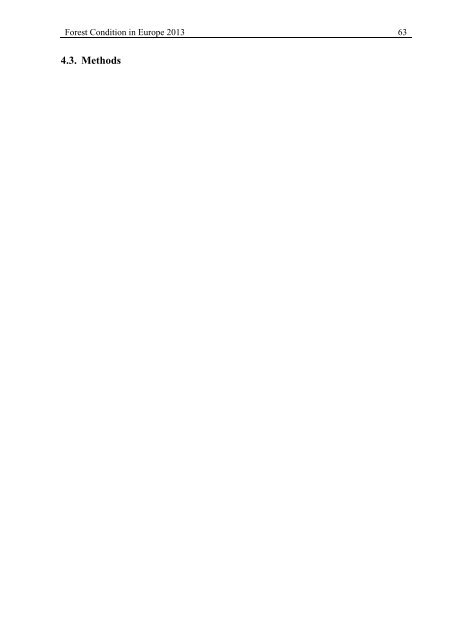Forest Condition in Europe - ICP Forests
Forest Condition in Europe - ICP Forests
Forest Condition in Europe - ICP Forests
You also want an ePaper? Increase the reach of your titles
YUMPU automatically turns print PDFs into web optimized ePapers that Google loves.
<strong>Forest</strong> <strong>Condition</strong> <strong>in</strong> <strong>Europe</strong> 2013 63<br />
4.3. Methods<br />
Cont<strong>in</strong>uous sampl<strong>in</strong>g of throughfall (TF) and bulk deposition (BD) is carried out on <strong>ICP</strong> <strong>Forest</strong>s<br />
<strong>in</strong>tensive monitor<strong>in</strong>g plots (Level II) and at a nearby open field, respectively. The methods<br />
used <strong>in</strong> the countries fulfil the requirements def<strong>in</strong>ed <strong>in</strong> the <strong>ICP</strong>-<strong>Forest</strong> Manual (earlier<br />
versions and <strong>ICP</strong>-<strong>Forest</strong>s, 2010) to a large extent (Norway: Kvaalen et al., 2002; Moffat et al.,<br />
2002; Italy: Mosello et al., 2002; Switzerland: Thimonier et al., 2005; Czech Republic:<br />
Boháčová et al., 2010; UK: Vanguelova et al., 2010; Wu et al., 2010a; Swedish Throughfall<br />
Monitor<strong>in</strong>g Network (SWETHRO): Pihl Karlsson et al., 2011). Collectors (10 to 20 replicates)<br />
are placed <strong>in</strong> the forest based on a random or fixed design <strong>in</strong> order to cover the spatial<br />
variation. Tests to determ<strong>in</strong>e the m<strong>in</strong>imal number of samplers required to cover spatial variations<br />
to ga<strong>in</strong> a representative plot mean have been carried out on a number of plots (e.g. Thimonier,<br />
1998; UK: Houston et al., 2002; Belgium: Staelens et al., 2006). Some samples are<br />
collected at least monthly, filtered, and then stored at about 4°C before chemical analyses are<br />
performed to determ<strong>in</strong>e the concentrations of the macronutrients. The laboratory results are<br />
checked for <strong>in</strong>ternal consistency based on the conductivity, the ion balance, the concentration<br />
of organic N and the Na/Cl ratio, and are repeated if suspicious. The QA/QC procedures further<br />
<strong>in</strong>clude the use of control charts for <strong>in</strong>ternal reference material to check long-term comparability<br />
with<strong>in</strong> national laboratories as well as participation <strong>in</strong> periodic work<strong>in</strong>g r<strong>in</strong>g tests<br />
(e.g., Marchetto et al., 2006) to check <strong>in</strong>ternational comparability.<br />
Data was submitted annually by countries to the Programme Coord<strong>in</strong>at<strong>in</strong>g Centre (PCC),<br />
checked for consistency and stored <strong>in</strong> <strong>ICP</strong> <strong>Forest</strong> database.<br />
We selected the data used <strong>in</strong> the analysis by apply<strong>in</strong>g the follow<strong>in</strong>g criteria to the deposition<br />
data from the years 1998 to 2010: (i) cont<strong>in</strong>uous sampl<strong>in</strong>g dur<strong>in</strong>g >330 days per year, (ii)<br />
non-miss<strong>in</strong>g concentration values for >330 days per year. Hereby, sampl<strong>in</strong>g periods with<br />
mean precipitation below 0.1 mm days -1 were counted as non-miss<strong>in</strong>g even if no chemical<br />
analyses could be performed.<br />
S<strong>in</strong>ce precise dates of the sampl<strong>in</strong>g periods have not been submitted for data collected before<br />
2007, the sampl<strong>in</strong>g dates were reconstructed based on start and end date and the number of<br />
sampl<strong>in</strong>g periods per year. Data of the sampl<strong>in</strong>g periods were <strong>in</strong>terpolated to regular monthly<br />
and annual data with three steps: (i) <strong>in</strong>tersection of sampl<strong>in</strong>g periods at end of months/years<br />
distribut<strong>in</strong>g precipitation quantity proportional to the duration to the new sampl<strong>in</strong>g periods,<br />
/split of every sampl<strong>in</strong>g period overlapp<strong>in</strong>g two consecutive months <strong>in</strong>to two new sampl<strong>in</strong>g<br />
periods, by distribut<strong>in</strong>g precipitation quantity <strong>in</strong> proportion to the duration of the new sampl<strong>in</strong>g<br />
periods (ii) us<strong>in</strong>g deposition=0 for periods with miss<strong>in</strong>g concentrations and mean precipitation<br />
< 0.1 mm day -1 (iii) calculation of the deposition fluxes qc (kg ha -1 a -1 ) of these periods<br />
by multiply<strong>in</strong>g precipitation quantity q (L m -2 ) with the concentrations c (mg L -1 ) with<br />
qc = 0.01 q c<br />
and summ<strong>in</strong>g up the fluxes of months and years.<br />
Both bulk precipitation and throughfall deposition of sulphur were corrected for the contribution<br />
from sea salt to estimate the anthropogenic part of sulphur deposition SO 4<br />
--<br />
corr (mg L -1 )<br />
with<br />
SO 4<br />
--<br />
corr = SO 4 -- - 0.54 Cl -<br />
where SO 4 -- and Cl - (mg L -1 ) are the concentration of sulphate and chloride.<br />
Trend analyses were carried out with (i) l<strong>in</strong>ear regression (LRegr) (Granke & Mues, 2010)<br />
and (ii) Mann-Kendall (MK) test (Mann, 1945; Helsel & Hirsch, 2002) us<strong>in</strong>g annual
















